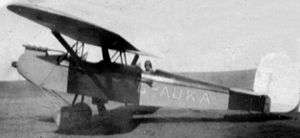Kookaburra (aircraft)
| Kookaburra | |
|---|---|
 | |
| Type | Westland Widgeon |
| Construction number | WA1775 |
| Registration | G-AUKA |
| Owners and operators | Keith Anderson |
| Last flight | 10 April 1929 |
| Fate | Abandoned in the Tanami Desert until remains were recovered and preserved |
| Preserved at | The remains are on display at Alice Springs |
| Accident | |
|---|---|
| Date | 10 April 1929 |
| Site | Tanami Desert, Australia |
| Aircraft | |
| Aircraft type | Westland Widgeon |
| Registration | G-AUKA |
| Crew | 2 |
| Fatalities | 2 |
| Survivors | 0 |
Kookaburra was a Westland Widgeon light aircraft registered G-AUKA.
When Sir Charles Kingsford Smith and his crew in the Southern Cross disappeared during the "Coffee Royal" incident in 1929, pilot Keith Anderson and mechanic Bob Hitchcock flew in Kookaburra to search for the men. Kookaburra departed Richmond, New South Wales on 10 April and headed for the north of Western Australia via Broken Hill, Maree, Oodnadatta and Alice Springs.
Kookaburra was forced to land in the Tanami desert when the push rod on a valve on number two cylinder loosened, causing a loss of power. Hitchcock adjusted the push rod and the two men attempted to clear a runway. They were overcome by thirst and perished before they could clear a runway long enough. Their bodies were found on 21 April 1929.
A ground party traveled from Wave Hill Station and buried the men where they lay. Due to a shortage of water, the ground party did not have time to clear a runway long enough for Kookaburra to take off. After a public outcry for leaving the men in the desert, a second expedition with a Thornycroft truck returned to the site and exhumed the bodies. Again, due to a shortage of water, a runway could not be cleared so the aircraft was not moved. In July 1929 Anderson was re-buried in Sydney and Hitchcock in Perth.
Kookaburra remained in the desert as it was not economical to recover it. It was unexpectedly discovered in 1961 by Vern O'Brien, a surveyor traveling through the area. It had been damaged by three decades of rain and bushfires. O'Brien did not ascertain an accurate location for the aircraft because the Tanami is flat and featureless. Several expeditions searched for Kookaburra after 1961 but to no avail.
Australian businessman, pilot and adventurer Dick Smith mounted an expedition in 1977 to find the Kookaburra but was unsuccessful. He searched again in 1978 and this time succeeded in finding the remains of the aircraft.[1][2]
The remains of Kookaburra were moved to a public display at Alice Springs Airport and are currently at the Central Australian Aviation Museum.
References
- ↑ Dick Smith (1980). Kookaburra, the Most Compelling Story in Australia's Aviation History. Lansdowne Press. ISBN 978-0-7018-1357-4.
- ↑ GEO Magazine Vol 1, No 2, 1979, pages 112 to 131
External links
- Accident description at the Aviation Safety Network
- Down Under: Travels in a Sunburned Country by Bill Bryson. Chapter 17.
Coordinates: 23°42′8″S 133°51′51″E / 23.70222°S 133.86417°E